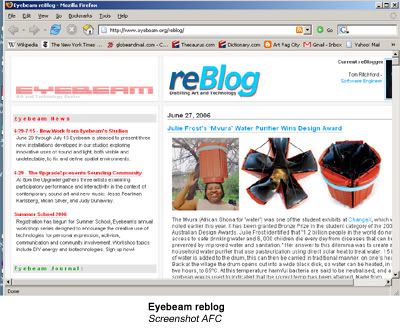I think it is high time the critique of the art and technology reblog is revisited, or rather the A&T reblogger, since this technology like any other software is only as good as its “superuser”. Consider this post a call for a greater effort within the discipline. Eyebeam has been the worst offender in recent months since they publish something from the same sources — Make, Boing Boing and Treehugger virtually every day. Rhizome fairs much better on this, though I still end up looking at We Make Money Not Art more than twice a day for no other reason other than I visit both sites. This sort of thing is great for those who don’t already read the blogs listed, but given the demographic these organizations target, I would place that ratio at roughly 2 boing boing newbies to every 1000 reblog visitors. I have a news reader for these sites, I don’t also need a reblog.
Another issue I have with rebloggers (and blogs in general), is a tendency towards lazy linking. If the function of a reblog is to be a resource, the quality of that resource is greatly reduced when the reblogger doesn’t link to the source material (Update for clarity: ie reblogs linking to reblogs as opposed to the source). Internet users want to use the fewest number of clicks to get an article, so creating an extra step to it ensures that you lose 50% of your audience along the way. I would also note that scholars have long encouraged the practice of seeking out original source material not only because it provides the full context for the response, but it usually contains the most valuable information.
If we work off the idea that the reblog is intended to be used as a resource, the one thing I think is really great about the Eyebeam model is that they chose different reblogger every two weeks, thus ensuring a greater range of web surfing. Rhizome takes the superuser model (in other words they have staff rebloggers as opposed to rotating in guest rebloggers), which works well for them since their “superusers” actually live up to their titles, but no matter how good a reblogger is, you can become accustomed to their style and anticipate what they will post. In theory, the Eyebeam set up eliminates this problem, but they have been using the human tech-bot web surfer for some time now, so a little investigation into some new curatorial vision would be nice. I would suggest Rick Silva (who currently maintains an excellent take on the reblog RSS Jockey) , Paul Slocum, Guthrie Lonergan, my recent interviewees Michael Bell-Smith and Tom Moody (who has been a reblogger for Eyebeam in the past) Joy Garnett (another reblogger), and even myself (though, admittedly I’m a gamble – I read a lot of crap that probably doesn’t deserve reblogging, but you’d probably get more cool stuff from Canada than usual).
What I would really like to see is a few more rebloggers tapping into my delicious again. In 2004 reblogger (and ubiquitious new media guy) Jonah Peretti was all about doing this, which was great. I read all sorts of stuff I’d never find on my own, which to my mind is what makes a good reblog. This, coupled with an effort to make connections within the articles you post, and the addition of liner notes that are witty or add additional explination to the content, are the things that make these sites a valuable resource. To reitterate my original statement, I’d like to see a little more of this.
UPDATE: A point missed which may fall into personal taste is that Eyebeam would do well to use their reblog as their main page. A giant perk in doing so is that it would eliminate their current splash page, which uses the “I am without content and in black in white, until your mouse scrolls over me” school of design – a bell and whistle I can do without. Also, I imagine the reblog is the most heavily trafficed part of the site, so why not make it a little easier to find? The organization could highlight their upcoming events and exhibitions on the reblog splash page and it would create a more efficient navigational path for the user.



Comments on this entry are closed.